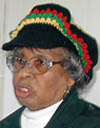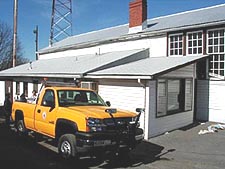|
|
|
|
|
Politics
|
|
Bus Tour Spotlights Segregated Schools of Montgomery County's Past
By Charmere Gatson Maryland Newsline Thursday, March 18, 2004; video added March 19, 2004 ROCKVILLE, Md. -- “Anywhere you find dirt roads and tracks, you’ll certainly find an African-American community,” said Anita Neal Powell, a member of the Lincoln Park Historical Foundation. Powell’s assertion may have been fact 50 years ago. But if you search today for those landmarks in the once-segregated communities of Maryland, you may come up short – finding only a few remnants of the trails, muddy springs, log cabins and one-, two- and three-room schoolhouses that once identified black communities. In Montgomery County, some of the black-only school buildings no longer exist, while others have been transformed into community centers, museums and even a landfill. But though the structures are no longer what they used to be, their rich history lasts.
That history and its unique spotlight on a segregated past were highlighted on a recent bus tour of more than 10 of the county’s former black-only schools. The tour was timed to pique interest in the anniversary of the U.S. Supreme Court’s Brown vs. Board of Education decision. That ruling — made 50 years ago this May -- declared that segregation of public schools “solely on the basis of race” denied black students an equal education. It stood as a giant step toward integrating U.S. schools. The tour prompted stories from former graduates of the miles-long walks to classes; battles with freezing temperatures in and out of the classroom; and teachers who boarded in homes with their students. While some reminisced about happy days as students, others recalled the verbal abuse and beefed-up security during integration. Similar bus tours are scheduled during the next two months for Frederick, Howard and Prince George’s counties and Baltimore and Annapolis. Separate and Unequal First stop on the Montgomery County tour: George Washington Carver Educational Services Center on Hungerford Drive in Rockville, just northeast of the historic black community of Haiti. The center is now home to county Board of Education administrative offices. But it was originally a black senior high school and the only institution for blacks to receive post-secondary education in the county’s segregated system. According to tour guides, the original brick structure – built in 1951 at a cost of nearly $428,000 – consisted of 10 classrooms, a science lab, a library, offices, cafeteria and band room. The facility was renovated in 1952 to accommodate Carver Junior College, an accredited black community college. Nearly 125 students attended classes there in evenings and on weekends, until Carver merged with Montgomery College after desegregation. The building is more than bricks and mortar to Warren Crutchfield, 67. The school played a vital role in promoting lasting social and professional bonds, said Crutchfield, who was the first black coach of a varsity sport in Montgomery County. He coached at Sherwood High School in 1966 and 1967. Teachers were very involved with their students, and those from out of town lived in homes with students’ families, he said. “It was difficult to be disruptive in school when you would have to face the teacher at home sitting across the dinner table from you,” said Crutchfield, who remembers getting “tattered” books and “hand-me-down” science lab supplies and gym equipment. But having it tough made him stronger, he said. “I wouldn’t take anything from the journey I have gone.” Crutchfield later attended the formerly segregated University of Maryland, Eastern Shore, before launching his career as a teacher and coach.
Nearby in the Lincoln Park community of Rockville, Alma King Ridgley, 75, wasn’t surprised to find a sign change when the motor coach pulled up to the front door of the structure that once was home to “12 classrooms and some caring teachers”: Lincoln High School. The numerals 595 and the school bell still hang above the front door, but now the North Stonestreet Avenue building is home to the Crusader Baptist Church of God. But just being around the place she called school gave Ridgley, a 1946 Lincoln graduate, a flashback to her high school years: “School was fun because it was an opportunity to get away from house chores,” she said. But getting there wasn’t easy. “I lived in a small town away from here and traveled two hours every day to get to school,” she said. She first had to walk two miles to the nearest highway, because buses only picked black students up along main stretches of road, she said. She recalls how the poor whites who lived in the black communities would attend separate schools closer to home, and her bus would pass the white schools on the way to Lincoln. Rosenwald Schools Among the other stops on the tour were Rosenwald schools. The brainchild of Julius Rosenwald, once president of Sears Roebuck & Co., the Rosenwald Fund aimed to establish a colored school in every rural county in the South.
Each of the Rosenwald schools was equipped with the bare essentials – including a potbelly stove for heat in winters – but was built on a minimum of two acres to have space for playgrounds, officials said. Helen Thompson, 75, who attended classes in a one-room Rosenwald schoolhouse at Gaithersburg’s Quince Orchard Colored School, recalled tough times. “After we had walked to school in the winter time, we’d arrive into a stone cold classroom, even with the stove,” she said. “We were always the last to get anything – especially transportation.” In Poolesville, Md., the Poolesville Colored School, which operated as a Rosenwald schoolhouse from 1925 to 1949, has been modified to support solid waste, refueling and other automotive services operations of the Montgomery County Department of Public Works and Transportation. Integrating the Schools
The tour sites represent the educational, social and political coming-of-age for the county’s black community, Crutchfield said. But they also serve as reminders of the struggles and achievements of those who passed through their halls, he said. On June 8, 1954, a few weeks after the Brown decision, discussions of integration appeared in the Montgomery County School Board’s record for the first time, according to Nina Clarke, the first teacher specialist in language arts for the county’s colored schools. Clarke’s book, “History of the Black Public Schools of Montgomery County, Maryland, 1872-1961,” details the integration debates of 1954 to 1961. In 1955, only 16.6 percent of the county’s black students attended desegregated schools, but that number increased over the course of five years to nearly 73 percent in 1960, both the book and county school board officials confirmed. By 1961, Montgomery County Public Schools were fully integrated, according to school board officials. “This marked the official end of 89 years of sanctioned, separate and unequal public educational opportunities for the black students of Montgomery County, Md.,” Clarke said. But the changes – and challenges – continued. George Barnes, one of the first nine black students in 1956 to integrate Poolesville High School, a near-final stop on the tour, said he remembers having to enter the school through the back door and often having trash thrown into his family’s front yard. The school was one of the first integrated high schools in the Montgomery County area, school board officials said. “It was a tough couple of years, because I wasn’t able to spend 100 percent of the time in studies. Instead, I spent more time protecting myself,” he said. "Montgomery County provided police protection for the first three months. "Now I consider those experiences to be a character-building point in my life.”
Banner photo courtesy Joseph Douglas Collection, Kansas Collection, Spencer Research Library, University of Kansas Libraries Copyright © 2004 University of Maryland Philip Merrill College of Journalism
|









